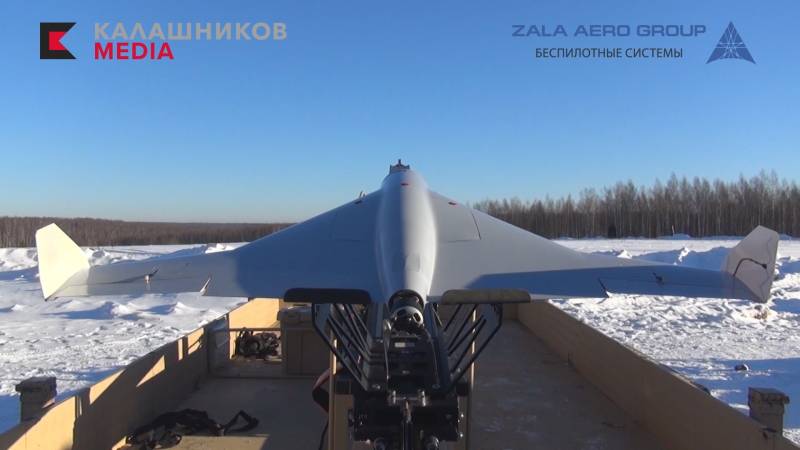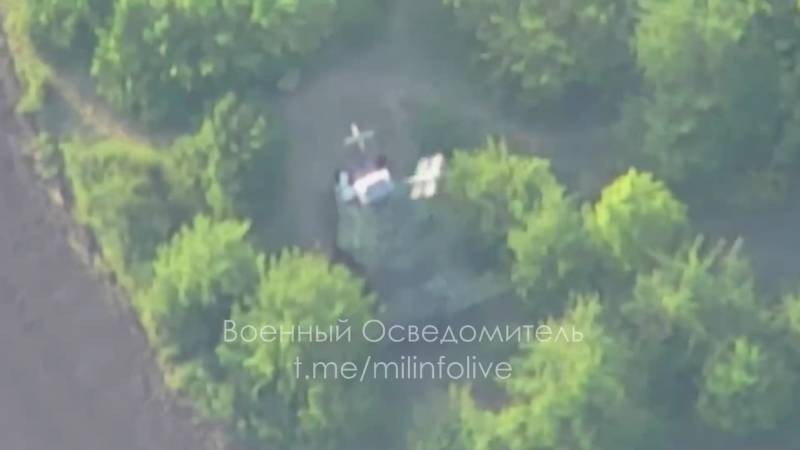The evolution of Russian loitering ammunition against the backdrop of the Special Operation

UAV/BB "Kub-ULA" on the launch guide. Photo by Zala Aero / Kalashnikov Concern
Several types of loitering ammunition have recently entered service with the Russian army. This technique is now actively used in the Special Operation zone and hits various targets. In addition, a number of enterprises are engaged in improving finished structures and creating new ones. drones-kamikaze. When developing such projects, accumulated operational experience is used, which has a positive effect on the results of combat use.
Starting positions
The Russian military-industrial complex seriously took up the topic of loitering munitions (AM) in the second half of the XNUMXs. By the end of this period, the first samples were presented. At that time, testing and refinement of designs were carried out, and at the same time, concepts and tactics for their application were being formed. As a result of these processes, by the beginning of the Special Operation, our army managed to receive a certain number of BBs of two main types.
The first domestic BB presented to the general public was the “Cube-UAV” product from the Zala Aero company. It was made in the form of a plastic “tailless” with an electric motor and a pushing propeller. With a wingspan of approx. 1,2 m and weighing less than 10 kg, the drone carried a 3-kg warhead. The flight is carried out according to satellite navigation signals to a pre-specified target. The development of an optical-electronic system for target search and guidance was also reported.
Simultaneously with the “Cube”, the Lancet series BBs were created; in 2019-20 presented two such products with different dimensions and load. Both versions of the Lancet had a characteristic aerodynamic appearance with an elongated fuselage and two sets of X-shaped planes. The light modification “Lancet-1” weighed 5 kg and carried a warhead weighing 1 kg. Lancet-3 had a mass of 12 kg and carried a 3 kg load. The flight range reached 40 km; flight and guidance were carried out using an optical system.
Apparently, before the beginning of 2022, the domestic industry was working on other BB projects - both completely new and based on existing designs. However, the results of these projects, suitable for use in practice, appeared after the start of the Special Operation.
Against the background of the Special Operation
Along with other weapons and equipment, in the spring of 2022, Russian troops involved in the Special Operation began to use the existing warheads. The ammunition used caused some damage to the enemy, and also helped to practice existing tactics of use. In addition, with their help, they accumulated experience for further operation and development of the design.
Taking into account new data, the existing BBs were modernized. Thus, the most actively developing of the “old” developments is the Lancet family. According to known data, the serial Lancet-3 has undergone modernization. Search and guidance equipment was replaced on it, and various combat units were installed. In order to increase protection against interference and interception, the remote control system and communications equipment were updated.
Completely new shock systems are also being developed, similar to the previous technology only in name. Thus, within the Lancet family, samples of reduced size and weight, long-range armored vehicles, new variants of warheads, etc. have been developed. Some of these products have already reached the front and are being actively used.

The Lancet dives into the Bukovel electronic warfare station. Photo Telegram / "Military informant"
As parts of helicopter-type UAVs became saturated, a new class of loitering munitions was formed. By installing one or another ammunition, the available copter turned into an FPV attack drone. This concept is simple, which has contributed to its widespread use. FPV kamikazes are manufactured in large quantities in different ways. They can be assembled from existing UAVs of any model, simply supplementing them with warheads, or built according to a special project.
Due to active use and a corresponding increase in the needs of troops, industry is expanding production. For example, the experience of one of the large companies that bought shopping centers and organized the production of UAVs and BBs in them became widely known. In addition, groups of enthusiasts have joined the production of such equipment. The simplest samples of loitering ammunition and FPV kamikazes can be assembled directly in military workshops.
Experience of application
During the Special Operation, our BB crews managed to accumulate extensive experience in operating such equipment, as well as find and/or improve methods for its effective use. At the same time, to date, a large number of products have been expended and a comparable number of targets have been hit. In general, it can be argued that BBs have become one of the most important strike weapons of the army.
According to the Lost Armor database, compiled on the basis of open and accessible information, Kub-UAV aircraft have been in use since May last year. Due to technical features, their use is not intensive - the authors of the database counted only 44 such episodes. 28 APs hit or damaged the target; the results of another 7 episodes are unknown. However, the actual amount of ammunition used may be significantly higher.

The FPV drone is heading towards the target; shooting with a UAV camera. Photo Telegram / "BOBR"
The Lancets of all versions are more widespread. Since July 2022, almost 700 episodes of their use have become known. Almost 590 products destroyed or damaged targets; the results of 60 episodes of use are unknown.
According to Lost Armour, FPV drones are being used even more actively, with 1466 such entries in the database. More than 1 thousand kamikaze vehicles hit, damaged or destroyed the target. For 227 cases of use, precise outcome data are not available.
Loitering ammunition is used against the entire range of targets present on the battlefield or behind enemy lines. Thus, “Lancets” are actively working against all types of artillery, in positions and on the march, as well as against armored vehicles. Episodes of successful destruction of NATO-style armored vehicles, incl. modern tanks. In addition, in recent weeks, extended-range UAVs have begun to be successfully used against targets at remote airfields.
FPV drones carry less powerful combat units. In this regard, they are used against concentrations of manpower and enemy positions, against unprotected equipment and other “soft” targets. Less high combat characteristics are compensated by relatively low cost. This makes it possible to make such warheads more widespread and to use them more actively in all sectors of the front for various tasks.
Technical evolution
Thus, in just a few years, Russian loitering ammunition has come a long way from new products at the exhibition to a full-fledged and massively used strike weapon of the armed forces. It is not difficult to see how this situation developed and what changes the direction as a whole and individual samples underwent.

M2 Bradley infantry fighting vehicle through the lens of an FPV drone. Photo Telegram / "BOBR"
Several years ago it all started with the development of two main samples with different architectures, fundamentally different methods of application, etc. The BBs of the first models were tested at domestic test sites and in Syria, and based on the results they were improved. By this time they were already being mass-produced and supplied to the troops.
The special operation to protect Donbass made it possible to evaluate the potential of existing warheads in the context of mass use against an advanced enemy with foreign equipment. In addition, appropriate production rates were needed. The demilitarization of the Kyiv regime also made it possible to accumulate experience and determine ways for further development of technology. New ideas have already been implemented in the form of projects and brought to series, and are also being used in practice.
After the start of the Special Operation, the development of the domestic direction of combat FPV drones began. In the shortest possible time, enterprises and enthusiasts were able to create such equipment, set up production and provide it to the troops. The army, in turn, uses the acquired capabilities and massively uses the received warheads.
The evolution of domestic loitering ammunition began not so long ago, but has now come a long way. The results of these processes are well known, and the need for BB no longer raises questions or disputes. Now we are talking only about continuing the development of an important and useful area.

Information